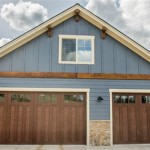Building A Garage Yourself: A Cost-Effective Strategy
Constructing a garage offers numerous benefits, providing secure storage for vehicles, tools, and equipment, as well as adding value to a property. While hiring a professional contractor ensures expertise and efficiency, it often comes with a significant financial burden. Building a garage independently, although demanding, presents a viable, cost-effective alternative for homeowners with the necessary skills, time, and dedication. This article will delve into the complexities of DIY garage construction, outlining key considerations, potential cost savings, and essential steps to ensure a successful project.
Initially, careful planning is crucial. Before commencing any physical work, it is imperative to thoroughly research local building codes and regulations. Zoning restrictions, setback requirements, and permit applications must be addressed to avoid potential legal issues and costly delays. Failure to comply with local ordinances can result in fines, mandatory modifications, or even demolition of the non-compliant structure. Additionally, a detailed blueprint or construction plan is essential. This plan should outline the dimensions of the garage, the type of foundation, framing materials, roofing specifications, and electrical and plumbing layouts if applicable. A well-defined plan serves as a roadmap throughout the construction process, minimizing errors and ensuring structural integrity.
The cost-effectiveness of a DIY garage project stems primarily from the reduction in labor expenses. Professional contractors typically charge a considerable premium for their expertise and manpower. By undertaking the construction work independently, homeowners can eliminate these costs, potentially saving thousands of dollars. However, it is crucial to accurately assess one's own skill level and limitations. While enthusiasm is valuable, lack of experience can lead to mistakes that ultimately increase costs and compromise the quality of the finished product. If necessary, consider enrolling in relevant courses or seeking guidance from experienced builders or contractors on specific aspects of the project.
Key Point 1: Thorough Planning and Preparation
Effective planning and preparation are paramount to the success of any DIY garage project. This phase involves more than simply sketching a rudimentary design; it requires meticulous attention to detail and a comprehensive understanding of all the elements involved.
First and foremost, obtaining the necessary permits is non-negotiable. Contacting the local building department is essential to understand the specific requirements for garage construction in the area. This includes zoning regulations regarding the size, location, and height of the garage, as well as any specific design or material restrictions. The application process typically involves submitting detailed blueprints, site plans, and structural calculations for review and approval. Failing to secure the relevant permits can result in significant penalties and delays, potentially forcing the homeowner to dismantle the partially or fully constructed garage.
The design phase is equally crucial. The blueprint should accurately depict the dimensions of the garage, the placement of doors and windows, the type of foundation (slab, pier, or full basement), the framing plan, the roofing system, and the electrical and plumbing layouts, if applicable. It is advisable to consult with a structural engineer, especially for larger or more complex garage designs, to ensure structural integrity and compliance with building codes. The engineer can perform calculations to determine the appropriate size and spacing of framing members, the required thickness of the foundation, and the load-bearing capacity of the roof. This consultation, although an added expense, can prevent costly structural failures in the future.
Material selection is another critical aspect of the planning phase. The choice of materials will significantly impact the cost, durability, and aesthetics of the garage. Pressure-treated lumber is essential for framing members that come into contact with the ground, preventing rot and insect infestation. The type of siding (wood, vinyl, metal) will affect the maintenance requirements and the overall appearance of the garage. Similarly, the roofing material (asphalt shingles, metal roofing, tile) will influence the longevity and weather resistance of the structure. It is prudent to research different material options, compare prices, and select materials that are both durable and cost-effective.
Finally, a detailed budget should be developed, outlining all anticipated expenses, including materials, tools, permits, and any potential professional consultations. This budget should be realistic and account for potential unforeseen costs, such as material price increases or unexpected site conditions. Having a well-defined budget will help to track expenses and prevent financial strain throughout the project.
Key Point 2: Managing Material Costs and Efficient Construction Techniques
Controlling material costs and employing efficient construction techniques are vital for maximizing the cost-effectiveness of a DIY garage build. Strategic purchasing, careful material handling, and streamlined construction methods can significantly reduce expenses and accelerate the building process.
Sourcing materials strategically is a key element of cost control. Comparing prices from multiple suppliers, including local lumberyards, building supply stores, and online retailers, is essential. Bulk purchases can often yield substantial discounts, particularly for lumber and other common building materials. Negotiating with suppliers to secure the best possible price is also advisable. Furthermore, exploring alternative materials, such as recycled or reclaimed lumber, can provide significant cost savings without compromising structural integrity. However, it is crucial to ensure that any alternative materials meet local building codes and are suitable for the intended application.
Efficient material handling is equally important. Careful storage and protection of materials from the elements can prevent damage and waste. Lumber should be stored off the ground and covered with tarps to prevent warping and rotting. Proper planning of material deliveries to minimize handling and storage requirements can also reduce labor costs and prevent delays. Accurate material take-offs, which involve calculating the exact quantity of materials required, can prevent over-ordering and minimize waste. Utilizing cut lists, which specify the exact dimensions of each framing member, can further reduce waste and streamline the cutting process.
Employing efficient construction techniques can significantly accelerate the building process and reduce labor costs. Utilizing power tools, such as nail guns, circular saws, and drills, can speed up framing and sheathing operations. Pre-assembling components, such as wall frames, on the ground and then raising them into position, can save considerable time and effort. Utilizing jigs and templates to ensure accurate and consistent cuts and assemblies can also improve efficiency and reduce errors. Furthermore, organizing the worksite efficiently, with clearly designated areas for material storage, cutting, and assembly, can minimize wasted time and improve overall productivity.
Consider renting specialized equipment, such as concrete mixers or power lifts, rather than purchasing them outright, especially if they are only needed for a limited duration. Renting equipment can significantly reduce capital expenditures and avoid the costs associated with maintenance and storage. However, ensure that all rented equipment is operated safely and according to the manufacturer's instructions.
Key Point 3: Addressing Electrical and Plumbing Considerations
Integrating electrical and plumbing systems into a DIY garage project requires careful planning, adherence to safety regulations, and, in many cases, the involvement of licensed professionals. Improperly installed electrical or plumbing systems can pose significant safety hazards and result in costly repairs.
Electrical work, in particular, is subject to stringent building codes and regulations. In most jurisdictions, electrical installations must be performed by a licensed electrician. This requirement is in place to ensure that the wiring is installed safely and correctly, minimizing the risk of electrical shock, fire, and other hazards. If the homeowner is not a licensed electrician, it is strongly recommended to hire a qualified professional to handle all electrical work, including wiring, outlets, lighting, and circuit breakers. Attempting to perform electrical work without the proper knowledge and experience can be extremely dangerous and potentially illegal.
Planning the electrical layout carefully is essential. Determine the number and location of electrical outlets, lighting fixtures, and any specialized equipment, such as power tools or electric vehicle chargers. Ensure that the electrical system has sufficient capacity to handle the anticipated load. Consider installing ground fault circuit interrupters (GFCIs) in areas where water may be present, such as near sinks or washbasins. Conduct thorough inspections of all electrical work to ensure compliance with building codes and safety standards.
Plumbing installations, while potentially less hazardous than electrical work, also require careful planning and adherence to building codes. If the garage will include a sink, toilet, or other plumbing fixtures, it is necessary to connect to the existing water supply and sewer system. This typically involves running water lines and drain pipes to the garage. Depending on the complexity of the plumbing work, it may be advisable to hire a licensed plumber to ensure proper installation and compliance with building codes. Improperly installed plumbing systems can lead to leaks, water damage, and sewer backups.
Obtain all necessary permits for electrical and plumbing work before commencing any installations. These permits typically require inspections by local building inspectors to ensure compliance with building codes and safety standards. Scheduling these inspections in a timely manner can prevent delays and ensure that the electrical and plumbing systems are safe and functional.
Finally, consider the potential for future expansion or modifications. Installing extra electrical circuits or plumbing stubs during the initial construction phase can facilitate future upgrades and renovations without requiring extensive demolition and re-installation work.

8211 Tiger Way Riverdale Ga 30296 Mls 10545238 Trulia

8211 High Noon Way San Antonio Tx 78254 Updated 5 10

Planning Our 2 Story Tuff Shed Garage Counting The Costs Project Small House

Site Plans For Geothermal Heating And Cooling Ground Digging Permits 24h Building Plan Drawing Drafting Service

8230 Kepley Dr Ne Unit 65 New Salisbury In 47161 Updated 3 27

8211 Belle Grove Ct Riverview Fl 33578 Zillow

Diy Tall Planter Plans Great For A Garden Pine And Poplar

Modular Home Costs Pros Cons Planning Building Definitive Guide

8211 Ne 126th Drive Kirkland Wa 98034 Zillow

Planning Our 2 Story Tuff Shed Garage Counting The Costs Project Small House
Related Posts








